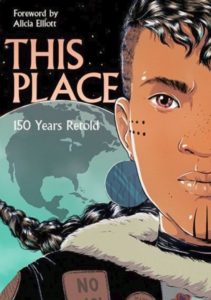Book review: This Place: 150 Years Retold
 By Karl Hele
By Karl Hele
Stories by Kateri Akiwenzie-Damm, Sonny Assu, Brandon Mitchell, Rachel and Sean Qitsualik-Tinsley, David A. Robertson, Niigaanwewidam James Sinclair, Jen Storm, Richard Van Camp, Katherena Vermette, Chelsea Vowel and illustrations by Tara Audibert, Kyle Charles, GMB Chomichuk, Natasha Donovan, Scott B. Henderson, Ryan Howe, Andrew Lodwick, Jen Storm and colour by Scott A. Ford, Donovan Yaciuk, comprise This Place: 150 Years Retold.
This Place: 150 Years Retold graphic anthology of timeless stories of Indigenous resistance and renewal in the face of Canadian colonialism. The collection is ever relevant considering the ongoing challenges for Indigenous peoples protecting our rights in the face of corporate and Canadian racism, greed, and colonial practices. As the forward by Alicia Elliot states, we as Indigenous peoples are living in a post-apocalyptic world brought about by contact and colonialism.
The 10 beautifully illustrated stories cover acts of courage and resistance. “Annie of Red River” by Katherena Vermette presents the story of Annie Bannatyne who publically whipped a racist Canadian expansionist, as well as inspired Louis Riel and other Métis to fight for their future (pp. 2-27).
“Titled Ground” by Sonny Assu explores Chief Billy Assu who played a role in continuing the potlatch in the face of colonial bans and arrests (pp. 28-53).
Jen Storm’s “Red Clouds” (pp. 54-81) is a story about the imposition of Canadian justice and its far reaching effects on a community through a windigo/woman’s eyes.
“Peggy” (pp. 82-109) by David A. Robertson explores the life of Francis Pegahmagabow.
Rachel and Sean Qitsualik-Tinsley in “Rosie” (pp. 110-137) explore Inuit belief and psychology or in the author’s words, an understanding of Inuit “psychotechnology.” This exploration occurs through the experiences of Rosie, an Inuit woman, in approximately the mid-twentieth century.
“Nimkii” (pp. 138-165) by Kateri Akiwenzie-Damm is an exploration of why a woman and a community, Wabasseemoong, stopped the Children’s Aid Society from stealing their children.
Richard Van Camp’s “Like a Razor Slash” (pp. 166-191) is the story of Chief Frank T’Seleie’s efforts and the Dene’s success in stopping the proposed Mackenzie Valley Pipeline in the 1970s.
“Migwite’tmeg: We Remember It” (pp. 192-219) by Brandon Mitchell is about the people at Restigouche experiencing Sûreté du Québec raids as they continued to fish according to Mi’kmaq laws.
“Warrior Nation” (pp. 220-145) by Niigaanwewidam James Sinclair is about an Anishinaabe teenager’s growing awareness of Indigenous struggles and efforts to support the defense of lands, people, waters, and rights through his involvement at Oka.
Finally, “kitaskinaw 2350” (pp. 246-277) by Chelsea Vowel uses time travel to explore flash points of the twentieth century in an effort to understand motivations of people who fled Earth and are now returning.
As an entirety, the volume is an emotional ride through key events told from Indigenous perspectives via graphic illustrations and texts. It is a wonderful book designed to encourage the reader to explore the history, contemporary relations, and interactions between Indigenous peoples and Settlers in Canada.
In an era of failed reconciliation or the Canadian idea of ‘reconciliation by accepting assimilation,’ This Place: 150 Years Retold offers a glimpse of people successfully resisting Canadian colonialism, while inspiring younger generations to do the same and perhaps find a path beyond our current post-apocalyptic existence. Simply, “these are stories that deserve to be retold, remembered, and held close.”
Kateri Akiwenzie-Damm et al. This Place: 150 Years Retold. Winnipeg: Highwater Press, 2019. ISBN: 978-1553797586


